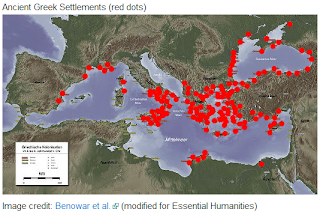About 800 B.C., the need for protection became more pronounced. Therefore, the village communities which had been centered around clan groups underwent a transformation to larger political units which would ultimately evolve into the Greek City-State. A central feature of these City-States was the acropolis, which means “high city.” The acropolis was a citadel built on a high location. I allowed the citizenry of the area to have protection against an invasion or siege. Therefore, a city would grow up around the acropolis. This settlement became a political and commercial center and various forms of government would emerge to manage the affairs of the city and its environs, the state. One form of government that arose from this evolving process was democracy. The largest and most prominent of these city-states were Athens and Sparta. They would have radically different forms of government and spheres of influence.
Generally Greek city-states experienced similar political transformations. They started out as monarchies. During the eighth century BC, they were generally changed into oligarchies. Around a century later, these oligarchies were overthrown by dictators as this became the period of "tyrants." Some ruled oppressively but the period of tyranny was counter to the basic essence of being Greek. The evolution process continued to where in the sixth and fifth centuries, other forms of governing arose that provided more freedom and responsibility for the Greeks. Certain city-states, like Athens, adopted forms of democracy. Other city states turned to a form of government called "timocracies" based on property ownership for participation.
These political changes were based on a growing ownership of land and economic prosperity in the region. As people became wealthy, they were not satisfied with having their politics dictated to them by kings or tyrants. This period was also characterized by a dispersion of people seeking more land and expansion of trade.
Greece has two geologic and geographic phenomena that shaped its development and evolution. Because of its proximity to the sea, no place in Greece is more than one hundred kilometers from the sea. Greece is also eighty percent mountains and is therefore was relatively poor in agricultural resources. The increase in population around this time period, plus the natural seafaring essence of the Greeks led to colonization of the known world. In lieu of importing food, the Greeks solved problems created by an expanding population by exporting people to other lands.
As land began scarce, settlements were increased in the islands and on the coast in the area of the Aegean and Ionian Seas. But this was not enough and a period of colonization occurred. Some of the colonies founded ended up being more famous than their founder as in the case of Megara’s foundation of Byzantium, later known as Constantinople and now, Istanbul.
The Greeks colonized extensively and by the end of this period had spread over an enormous area. Greek colonies could be found from the northern, western, and southern shores of the Black Sea through Western Asia Minor and Greece proper, including the Aegean islands, Sicily and southern Italy, and continuing west along both shores of the Mediterranean to Cyrene in Libya, to Marseilles, and to Spanish coastal sites. Wherever they went, the Greeks settled near the sea. Among the settlements founded by the Greeks are some of the great modern port cities like Istanbul, Naples, and Syracuse.
A positive externality of Greek colonization was a renewal of trade throughout the Mediterranean region. Often the colonies were strategically located and the colonists were able to inject raw materials into the trading pipeline, thus allowing for expanded production of finished goods. As is true today, prosperity for the Greeks was a natural consequence of the expanded trade made possible by the extensive colonization of the Greeks.
Trade also brought other benefits to the Greeks by bringing them in close contact with other cultures and practices. One of these great benefits was the alphabet. Around 750 BC, the Greeks began to trade with the Phoenicians, a people generally living along the southern coast of the Mediterranean, who utilized a Semitic script called the alphabet (from the first two characters, aleph, "ox," and beth, "house"). The Greeks incorporated this Phoenician alphabet into their own language. At some later time poets used the alphabet to preserve the Homeric poems, which originally were passed down as oral epics. Ultimately large regions of the world use a derivative of the Phoenician alphabet as transformed by the Greeks, that being either the Latin alphabet in the West or the Cyrillic alphabet in the East.
The Ancient Greek Thesaursus describes this period of economic transformation as: The consequence was a veritable economic revolution in the Greek world. Commerce and industry grew to be leading pursuits, the urban population increased, and wealth assumed new forms. The rising middle class now joined with dispossessed farmers in an attack upon the landholding oligarchy. The natural fruit of the bitter class conflicts that ensued was dictatorship. By encouraging extravagant hopes and promising relief from chaos, ambitious demagogues attracted enough popular support to enable them to ride into power in defiance of constitutions and laws. Ultimately, however, dissatisfaction with tyrannical rule and the increasing economic power and political consciousness of the common citizens led to the establishment of democracies or liberal oligarchies.
Greek colonies became independent Greek city-states. In spite of this independence, often the founding city-state would look to its colonies for support in certain areas. Such support was not always forthcoming and this led to conflict in the Greek world.


Δεν υπάρχουν σχόλια:
Δημοσίευση σχολίου